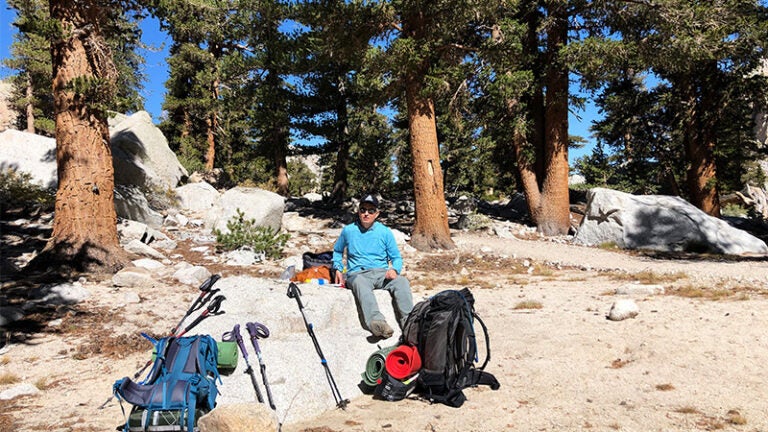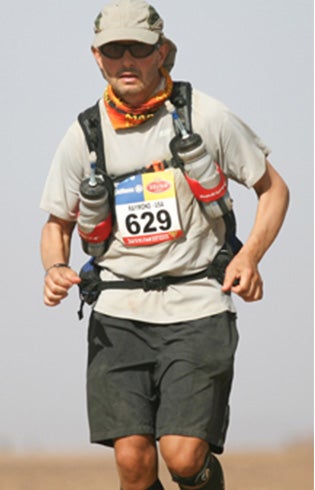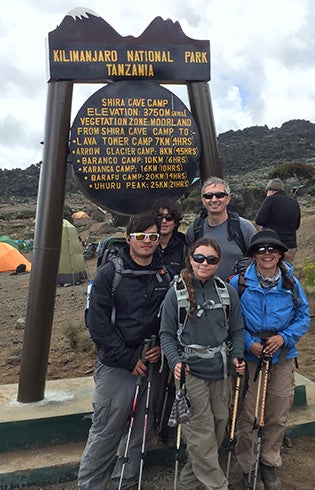
USC Dornsife faculty member embarks on journey to the top of the Earth
As a boy scout growing up in Maine, Ray Stevens nurtured two cherished dreams: to run across the Sahara Desert and to climb Mount Everest.
Stevens, Provost Professor of Biological Sciences and Chemistry at USC Dornsife College of Letters, Arts and Sciences, achieved his first goal 10 years ago when he completed the legendary Marathon des Sables — a 156-mile, six-day ultramarathon across the scorching sands of the Sahara that caused him to lose his toenails. Now 57, Stevens, director of the Bridge Institute at the USC Michelson Center for Convergent Bioscience, is preparing to fulfill his second dream by conquering Everest — almost exactly one year after his original plans were put on hold by the advent of COVID-19.

Stevens ran the Marathon des Sables to raise awareness about the rare metabolic disease phenylketonuria (PKU). He ultimately researched and developed a new drug to treat PKU.
His motivation in climbing Everest is also to raise awareness for rare diseases — an issue that remains close to his heart. Not only has Stevens’ scientific career been largely focused on understanding and treating rare diseases, his daughter, Sophia, was diagnosed with Kawasaki disease when she was four years old.
“Many of these diseases go undiagnosed, even by many trained physicians. People have symptoms but often don’t know the precise issue,” he says. “I was already working on rare diseases, but I’d never heard of this one. With Kawasaki disease, the immune system decides that the circulatory system is foreign, so it attacks it. Luckily, Jane Burns at the University of California, San Diego was doing a clinical trial with an experimental drug. It saved my daughter’s life.”
This experience spurred Stevens to commit to raising awareness for rare diseases by teaming up with the National Organization of Rare Disorders.
“Rare diseases are something that people don’t typically think of. It’s usually cancer, cardiovascular disease, diabetes, or today Covid-19. But rare diseases impact people in the same way and we should be aware of them,” Stevens says.
Stevens is also climbing to raise awareness of the Pulmonary Hypertension Association.
Climbing Everest, he says, is comparable to having pulmonary hypertension.
“As you climb, your lungs can’t get enough oxygen. The heart is really taxed, and so climbing Everest is the equivalent to having that disease.”
A family affair — but not this time
Stevens left Los Angeles for Kathmandu, Nepal, on March 31. He will then fly to the tiny airport of Lukla in northeastern Nepal. From there it will take nine days to hike to Everest Base Camp at 17,500 feet.
“The whole trip will take about two months and most of that time is spent acclimatizing to the very high altitude,” Stevens says.
During April and May, he will do “rotations” — climbing progressively further up Everest, sleeping there and then returning to base camp. Once acclimatized to the altitude, the final push to the summit takes about a week.
To prepare, Stevens has been regularly climbing Mount Whitney, the tallest mountain in the contiguous United States, located just three hours northeast of L.A.
“I sleep up there, then come down the next morning,” he says. “What’s wonderful in winter is that often there is nobody else up there, so I often get the whole mountain to myself.”
On his most recent ascent, he encountered temperatures of 5 degrees Fahrenheit and six inches of fresh snowfall overnight. However, that pales in comparison to what Stevens will face at the summit of Everest, where expected temperatures are minus 40.

For the past five years, Stevens has been steadily working toward his goal of climbing the seven highest peaks on the seven different continents. Accompanied by his two sons, the elder of whom, Nikolai Stevens, is a senior majoring in psychology at USC Dornsife, Ray Stevens has climbed Europe’s highest peak, Mount Elbrus, between Russia and Georgia; Argentina’s Mount Aconcagua, the highest mountain in South America; and Vinson Massif, the highest mountain in Antarctica. To climb Tanzania’s Mount Kilimanjaro, the highest free-standing mountain in the world, the trio were joined by Stevens’ wife, Vivian, and daughter.
This time, however, Stevens is on his own.
“After Antarctica, where we had to sleep outside for a month, my sons decided that was enough,” Stevens says. “I’m going to miss them very much because everything that I’ve climbed has been with them, but my wife is very happy that the boys aren’t going.”
“Just fight through it”
Stevens says the mental preparation needed to climb Everest began with running ultramarathons.
Asked about how he deals with pain and exhaustion, Stevens says, “You just fight through it.
“When I was running across the Sahara Desert, people were losing the skin on the soles of their feet because we were running in deep sand at temperatures over 120 degrees Fahrenheit. I lost all of my toenails, and it wasn’t a very pretty sight and it wasn’t comfortable, but you just keep going.”
Stevens says he is drawn to extreme sports in general and mountain climbing in particular because of the solitude and inspiration he finds in the beauty of the world around him.
“It’s really because I enjoy the journey so much. The adventure of it. It’s something where you find inner peace.”
Stevens says he feels ready for the ascent. Indeed, after years of training, he was ready to climb Everest last year. His bags were literally packed and stacked by the front door, when his dreams were temporarily thwarted by COVID-19. Now travel to Nepal has opened up and he has received the vaccine, Stevens is able to travel. However, he is under no illusions about what is facing him.
“Everybody says it’s incredibly hard to do, and even though there’s a lot of stuff in the media saying that it’s easier, it’s not easier. But it is safer because there are better weather prediction tools available and better equipment to try to avoid frostbite when the temperatures drop below minus 40.”
Asked what are the biggest challenges he expects to face on the climb, Stevens says his first concern will be staying healthy in a remote area at high altitude. Second is the first stage of the climb from base camp to Camp One through the dangerous Khumbu Icefall. Third are the challenges posed by the sheer number of people on the mountain. In a typical year, the weather window where one can summit lasts seven to 10 days, but in a bad year it can be only three days and everyone is trying to summit at the same time.
Stevens’ excitement about the climb is palpable.
“When I was first recruited to USC, I remember talking with then-Provost Elizabeth Garrett. She said, ‘Ray, are you seriously thinking of climbing Everest?’ And I said, ‘I’m excited to come to USC, but at some point I will need to take some time off because I’ve really been wanting to climb Mount Everest my whole life.’’
Now, Stevens is finally getting the chance to make his dream come true — and get the word out about rare diseases.
“For people who have any disease, including the rare ones, life is one step at a time, just like climbing a mountain,” Stevens says. “And no matter what mountain you climb, the advice is always the same: One step at a time.”